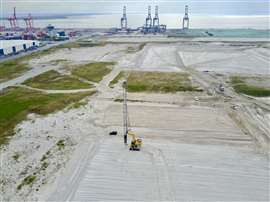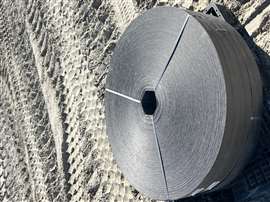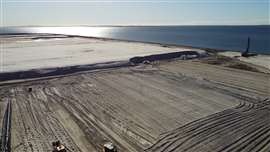How tech helped with giant land reclamation project
05 August 2024
Australia’s Port of Brisbane’s Future Port Expansion project is considered one of the largest reclamation efforts in the southern hemisphere, with the goal to develop approximately 224 hectares of new land as part of the artificial Fisherman Island.

It’s a task that requires hundreds of thousands of cubic meters of material and the installation of millions of meters of prefabricated vertical drains, essentially large straws, to dry out the subsurface materials.
Andrew Schweitzer, general manager for MGN Civil, said, “Conventional methods for installing wick drains were rudimentary at best, with contractors positioning the wick drains as best as possible, without an easy way to ensure that the drains were being installed accurately and at the intended location or depth. With no as-built digital records, quality control over tens of thousands of drains was nearly impossible.”
The port owners sought an accurate and automated solution. In 2017, they approached Queensland-based MGN Civil, a marine contractor that specialises in complex civil projects, about a better process. The solution needed to be able to automatically locate the planned wick drain position, measure placement depth, and ideally operate around the clock.
Machine control software
MGN Civil had an idea to develop a custom excavator equipped with Trimble machine control software. Now, five years since the first implementation, this solution continues to deliver progress for the Port of Brisbane.
Queensland’s Fisherman Island land reclamation requires detailed planning and patience. The first step is to build a perimeter rock wall to isolate the area of redevelopment. Then, MGN crews dredge material from the Brisbane River, which is pumped into large paddocks. The process usually takes over two years. Once ready, crews dredge sand from Moreton Bay and pump it into the paddocks to a depth of two meters.

Then, crews set about inserting the prefabricated vertical wick drains, ranging from 20m to 40m deep, in a diamond pattern across any single area, typically a 50x50m grid. The grid is imported to the onboard software and a ground-based rover system.
As the sand presses down on the surface, the drains act like a straw, allowing water to push up and out, running back out into the ocean. Once placed, the wicks are cut off leaving the area looking much like a paddock.
Next, crews place a design-specified amount of material, including surcharge sand and rock fill, such as waste rock, quarried rock or aggregate, to settle the ground in the required timeframe, typically 18-24 months. The weight of the rock fill squeezes more water out of the lower layers of the earth and up through the wicks.
Efficient wick placement poses the greatest challenge - and the most essential piece of the process as the location of these straws is crucial to ensuring as much moisture is pulled out of the reclaimed land as possible for greater long-term stability.
MGN Civil first worked with the equipment manufacturer to develop one of the most advanced and capable prefabricated vertical drain installation rigs in Australia, the Komatsu PC850 Prefabricated Vertical Drain (PVD) excavator.
Schweitzer said, “At 60m tall, it’s one of the largest wick drain installation machines of its kind. This machine is capable of achieving previously unattainable depths of up to 60m.”
First introduced by MGN Civil in 2018, the rig includes wide tracks and ground stabilizers to distribute weight (low ground pressure) to improve operational safety and reduce the risk of tipping over.
Next, MGN needed software to enable positioning and to measure and record depths. “Machine control software seemed like a possible fit, so we contacted our local SITECH Solutions partner,” Schweitzer continued.

Working closely with SITECH Construction Systems, the Trimble dealer in Australia, MGN equipped the PVD excavator with Trimble Groundworks software, a machine control solution originally designed for drilling, piling and dynamic compaction activities, to support the efficient modeling of the site and installation of wick drains without the need for surveying and as-built mapping.
With this solution, the excavator system can accurately position the wicks on the site to within 50mm, well within design specs.
In the cab with confidence

The Komatsu PC850 excavator equipped with Trimble Groundworks has been used to support successive land reclamation projects. Last year, crews completed the B1 Paddock Ground Improvement project phase of the Fisherman Island reclamation program. In this case, MGN Civil was responsible for installing two million meters of wick drains and over one million cubic meters of surcharge material.
To begin the effort, the Port of Brisbane sets the parameters for the number, spacing and depth range of wick drains in any given area. MGN Civil then conducts another site investigation, taking core samples to confirm what’s underneath, which as they’ve learned over time, varies considerably from soft mud to construction debris.
The subsurface data and project parameters are provided to MGN Civil’s surveyors, who then create the 3D DWG file showing the planned location and depth of each wick drain based on the information provided. The model is then imported into the Trimble Groundworks software to guide installation.
On the in-cab Trimble Groundworks monitor, the operator sees red dots where the wick drains should be placed. For each red dot, there are approximately 30 pieces of associated data visible, such as the easting, northing, expected sand depth, expected mud depth, expected hard clay depth, and more. Pressure readings are also recorded in real-time as the drain is installed to measure installation depth and resistance.
Visual red/green lights and audio cues to guide the operator through the installation process at each drain point. Red indicates that the drain is not installed; green indicates wick is installed to specifications.
Schweitzer said, “One of the brilliant things about the Trimble Groundworks software—and one of the things that the Port officials required – is true alignment with specified wick drain locations. With this software, our operator has to get within 150 millimeters of the hole location before the machine will allow the steel mandrel to begin pushing the wick drain into the soil.”
Once the mandrel begins to drive through the earth, the software measures and records the pressure (refusal), that is automatically sent to the Cloud, where a data operator manages the incoming data, converting it to simple graphs and reports for the owner.
According to Schweitzer, the software streamlines operations and quality control, allowing MGN Civil to install over 600 drains per day. Last year, MGN Civil installed two million meters of prefabricated vertical wick drains.
“We’re paid by the meter, so we try to install 16,000m of wicks every 24 hours, which averages out to about 600 wicks,” he said. “More importantly, we have also achieved an extremely high positioning success rate of over 99.5% across more than 80,000 drains installed on the most recent campaign, so over 300,000 wicks to-date.”
MGN has completed four campaigns at the Port of Brisbane, with a fifth scheduled to start in October this year, which requires the placement of more than 84,000 additional wick drains.




